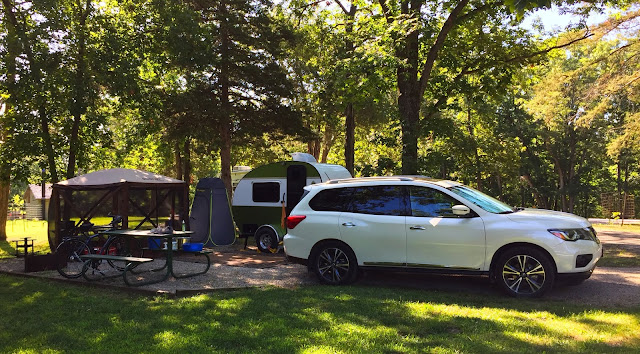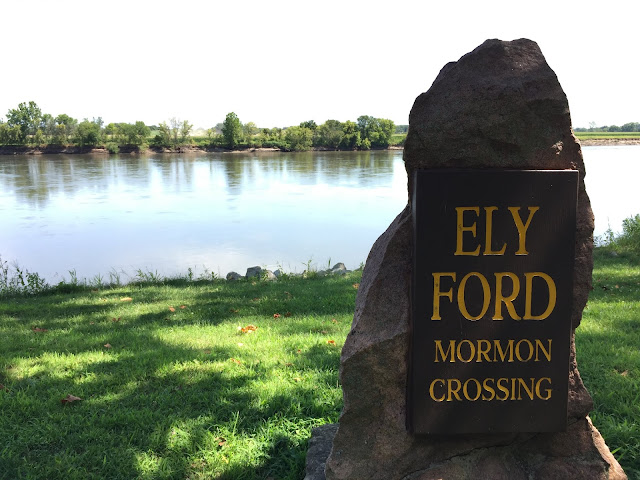First off, yes, I know that the "perfect" camping trip isn't possible without being flexible and allowing things to occasionally move in unexpected directions. Given that, my wife and I have reserved ten nights at our favorite spot at a local state park, and I'm going to dream a bit about what will make it perfect. Follow along and dream with me. At some point, I'm sure, your dream will take a left turn and take off on its own. That's the way dreams are.
A Good View
 |
| Indian Lake, Farmington, Iowa |
One main reason why I camp is to get out of the house and by extension to leave behind man's mark on the world. If I were a purist about this need, then I'd be backpacking in wilderness areas. Right now? I like to at least have a campsite with a good view. Sometimes our view of untrammeled nature is in small scale--when the trail drops down into a hollow or when I look in the direction of the woods and not the highway. Sometimes the weather paints a new face on a familiar scene, as in the photo above, where I woke up to a couple of inches of snow and a whole different dawn, the trees coated with ice. I try to find the older style campgrounds that were created for smaller rigs without full sewer hook-up. Those usually provide more space, a more organic layout of campsites, rather than the chevron patterns often seen, especially in full hook-up areas, and more older trees and shade.
The Pastoral Midwest
 |
| Howell Station Campground, Lake Red Rock, Iowa |
Much of Iowa is farmland--corn, beans, and pasture. The campgrounds fit into this Midwest landscape, often pockets of woods tucked among the fields. It's not uncommon to wake up at dawn to the lowing of cattle in the (not so far) distance. It's kind of peaceful; certainly, it's part of the Midwest experience. Having been raised camping in the Sierra Nevadas, Midwest campgrounds with beautiful lawns, deciduous trees, and lightning bugs was a new experience. Over time, I've come to discover the quiet beauty of the Midwest camping experience. To use words from my English literature background, it's bucolic or pastoral. It's easy to imagine the life rhythms of 150 years ago--fewer machine sounds (and no handheld electronics), potato salad and watermelon, a picnic blanket or a fishing pole. A second quality of camping I've come to cherish is that quiet hush of nature amid the busy, varied sounds of nature. There's a silence beneath the bustle of nature, a silence that somehow gets lost in the buzz of modern life. That peaceful coexistence is something I find on Rails to Trails bike rides, out in my garden, but especially in the quiet, mid-week hush of a county or state park at sunrise or sunset.
An Abundance of Water
 |
| Dawn, Lake Sugema, SE Iowa |
An abundance of water landscapes, river or stream, lake or sea, can never grow dull, can it? I would love to camp by the ocean, but most ocean expanses we have to share with a million other people. People pollution is a relative term, I suppose. Some people like or at least don't even notice the company. I am reminded of the austere and uncompromising poet Robinson Jeffers, who lived on Carmel Bay in California, building a forty-foot stone tower on the coast for his sanctuary. In his poem "Hurt Hawks," he writes: "I’d sooner, except the penalties, kill a man than a hawk," his unflinching and shocking affirmation of the unboundedness of the spirit (rather than any advocacy for murder). In a more mild manner, I can say that for me, water and space have a
healing, nurturing influence on me. A perfect camping trip would have to include some time immersed in the sights, sounds, and smells--the full sensual experience of water.
Embrace the Unexpected
 |
| 1st Place, bacon-wrapped, stuffed pork loin |
Although routine and familiar vistas are a big part of why people find camping relaxing, too much of the same thing can become tedious. Every kid will tell you that even the most serene pond needs a pebble tossed in once and a while, and for camping, the unexpected and surreptitious can send ripples of enjoyment through our quiet, outdoors idylls. For my wife and me, one such experience occurred when we were camping at a county park. Camping from midweek to midweek, we discovered that on the weekend a Dutch oven bake-off was scheduled. We knew the campground would be full, yet that weekend we met two other teardrop trailer owners who had come to compete in the bake-off. That Saturday we spent the morning watching the dozen or so teams cooking and spent a wonderful time learning all about Dutch oven cooking while interacting with all the contestants ("The Tear Droppin' Ladies at the Dutch Oven Cookoff"). As campers, we have to be open for such moments, finding beauty in the unexpected. Including the great variety of the world into our private lives enriches us.
Get Active
 |
| Hiking at Jefferson County Park, Iowa |
Finally, a perfect camping trip would include a chance for me to be active. Hiking and bicycling are the two main activities that I have engaged in so far. Some folks I know canoe or kayak, and I'm not disallowing those pursuits, but I'm not the "otter in the water" kind of guy that some folks are--or my wife is, for that matter. Also, in Iowa, the agricultural practices have polluted many of the waters, so swimming areas are posted with signs stating that water is tested once a week for E. coli--not a real incentive for me. Last winter when the temperatures were below freezing, my wife and I took long walks in our local county park. It was a joy--the exercise and fresh air, the good company, the lack of biting bugs. We hope to hike a lot more this fall.
There are many "perfect" possibilities that I've left out, of course. I've posted so many inspiring photographs from others on this blog. This is such a beautiful world we live in. I hope someday to be able to just take off and to visit many wonderful places and to camp in awe-inspiring settings. Until then, though, I'll discover and enjoy all the backyard beauty that I can, sometimes alone and sometimes with my wonderful partner. Also, the added satisfaction that the drive is no more than half a day's journey is an added pleasure. My dad was an old trucker who found long drives relaxing. Myself, I find short arrivals relaxing--but I'm willing to experience the alternative and see what it's like. Here's to perfect campsites and to the knowledge that "perfect" really comes from inside, that seeing harmony outside us requires possessing harmony within us--yet . . . what better place to find harmony within ourselves than within the cosmic harmony of nature? Maybe "glamping," in the deepest sense, is the beauty within us that we radiate into our camping world. Lights and bangles optional.
(Note: As the content for Green Goddess Glamping evolves, sometimes content focus will dictate that articles will be posted on some Facebook groups and not others. Articles on Dutch oven cooking, portable toilets, or bicycle day rides, for instance, could find posts in different groups. The best way to ensure that you are receiving all articles is to subscribe to follow this blog by email notifications.)






































